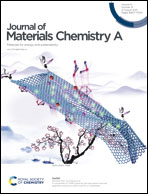Remarkable thermoelectric property enhancement in Cu2SnS3–CuCo2S4 nanocomposites via 3D modulation doping†
Abstract
P-type ternary sulfide Cu2SnS3 and CuCo2S4 with merits of low toxicity, natural abundance and intrinsically low lattice thermal conductivity are considered as promising eco-friendly thermoelectric materials. Here, we report a remarkable thermoelectric property enhancement in a Cu2SnS3-based nanocomposite material with the incorporation of 5 mol% CuCo2S4. Like the traditional modulation doping approach, in such a two-phase nanocomposite, charge carriers are mainly derived from the CuCo2S4 (metal-like) phase and transferred to the Cu2SnS3 (semiconductor) phase enabled by an appropriate band alignment. Results reveal that such a hetero-structure can simultaneously improve the unsatisfactory carrier concentration of both the phases to a moderate level and also maintain the high carrier mobility of pristine Cu2SnS3, contributing to an increased power factor of ∼10 μW cm−1 K−2 at 773 K. Meanwhile, the homogeneous distribution of the nanoscale minor phase can effectively impede phonon transport and results in a suppressed lattice thermal conductivity of ∼0.5 W m−1 K−1 at 773 K. Ultimately, a high ZT ∼ 0.83 has been achieved at 773 K which is comparable with that of the best Cu2SnS3-based material obtained by cobalt doping.



 Please wait while we load your content...
Please wait while we load your content...